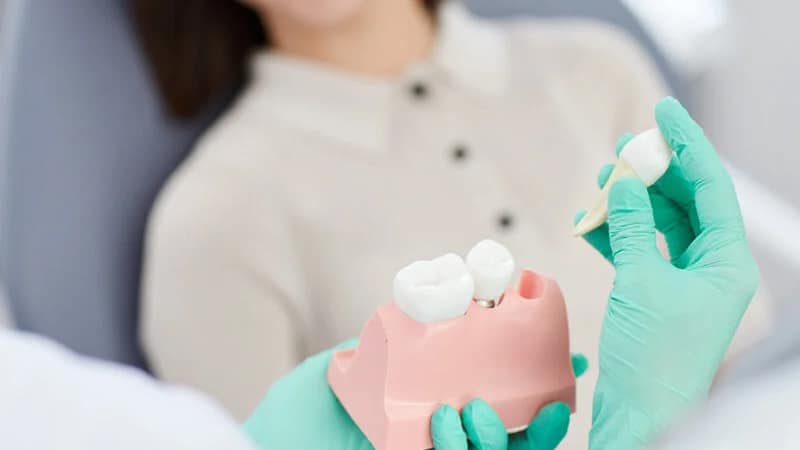What is a dental bridge?
Every tooth in the dental structure is important for the proper functioning of jaw movements. Tooth loss affects this jaw movement and also misaligns other teeth from their place since they may move towards missing tooth space making it look crooked. Teeth restoration is one of the best options to fill the missing space.
Dental bridges are teeth restorations that help in correcting the missing tooth issue.
Dental bridges are the devices that are used to bridge the gap between missed teeth and present teeth. The artificial tooth replaces the missing tooth space by taking the support of the other teeth present in the mouth. They are also known as partial dentures. The device is anchored on the natural teeth with dental crowns placed to support the replaced teeth.
When are dental bridges needed?
The dental bridges are needed for the following reasons:
- Maintaining the shape of the face.
- Regaining the biting ability in the missed tooth area.
- Preventing the other teeth from moving out of their position.
- Restoring the chewing ability with the artificial tooth
- Restoring the pronunciation and speech ability
Am I a good candidate for dental Bridges?
Dental bridges are appropriate for you if you have lost more than two teeth. But it is important to know if you are eligible to receive dental bridges by checking your overall health.
Dental bridges can be placed only if you have maintained good oral hygiene regularly.
If there are any gum diseases then it has to be resolved with proper treatment before going ahead with the bridge’s placement.
The dental bridges are supposed to be anchored safely between the natural teeth so having healthy and strong natural teeth is very important.
The bone density examination is done by the dental practitioner to know the exact strength of the bone to hold on to the bridges.
Types of Dental Bridges
There are three types of dental bridges that are used by dentists across NYC:
Traditional Bridges – these are the most common form of bridges used in the dental bridges procedure. This bridge consists of two or more crowns that are connected with a filler tooth also. The crowns attached will help in keeping the bridge in its place. The materials used in making traditional bridges are metal. Ceramics or metal fused porcelain.
Cantilever Bridge – These bridges are usually used for the back teeth. It is used when the teeth are present only on the adjacent side of the missing tooth.
Resin-Bonded Bridge – The bridge framework is made of metal or porcelain. The wings on each side are bonded to the existing teeth. These bridges are usually used for the front teeth.
Dental bridges procedure
Dental Bridges placement will be completed in 2-3 dentist appointments. Here are the detailed procedure details:
Preparation of Abutment Teeth – The first step is to reshape the abutment teeth. In this process, a part of the enamel and dentin is removed to make space for the crown.
Taking Teeth Impressions – The dentist takes impressions of the teeth or can also take digital scans of the teeth. It is sent to the laboratory for the preparation of the bridge, false teeth and crown. Until this process is completed a temporary bridge is placed in the missing tooth space.
Placement of Permanent Bridge – once the permanent bridges are ready the dentist removes the temporary bridge and places the permanent one. The proper placement is double-checked to make sure the recipient is comfortable. Any required adjustments are made according to the recipient’s requirements.
Advantages of Dental Bridges
It provides a natural look and restores the natural smile.
The pronunciation of hard words is difficult with missing teeth. Dental implants help in restoring speech ability.
A missing tooth may lead to bone loss and this can be avoided with dental bridges.
The chewing ability is hindered by the missing tooth. The dental bridges restore the chewing ability to enjoy different kinds of food.
Dental bridges prevent adjacent teeth from moving away from their place. It helps in avoiding complications attached to the movement of the adjacent teeth.
How to Care for Dental Bridges?
After the placement of the dental bridges, it takes some time for the recipient to adjust to the new biting pattern. Once adjusted, the bridges are very useful. The success of dental bridges is not only depends on looking after bridges and crowns but also depends on healthy natural teeth. Any gum infections and bacterial attacks may affect the dental bridges and also the natural teeth. To maintain good oral health with dental bridges, the following steps have to be followed:
Foods to Avoid – Avoid chewy foods such as meat and increase the intake of fibrous food, fruits and vegetables.
Regular Brushing and Flossing – It is important to do brushing and floss twice every day. A special type of floss is recommended by the dentist which can help in flossing between teeth and gums since more debris can form in between the gaps. The dentist would show the right way of flossing to maintain good teeth hygiene.
Dental Follow-Ups – Taking regular clean-up sessions with the dentist helps in detecting early infection and any other dental issues before they start affecting the bridges.


